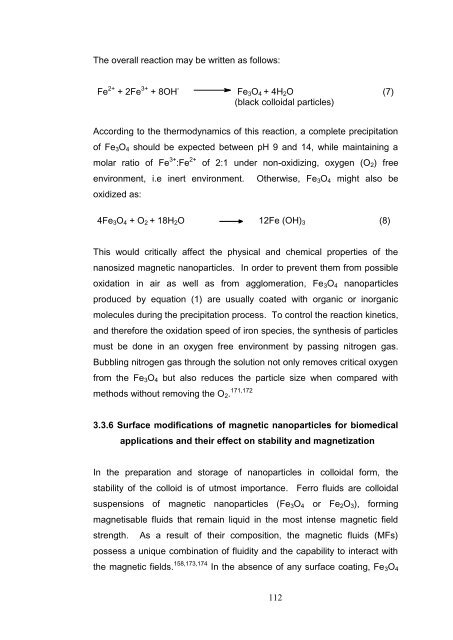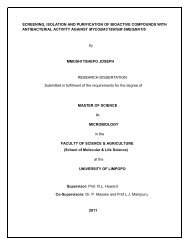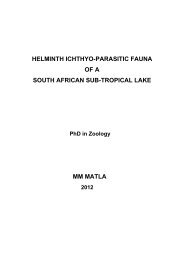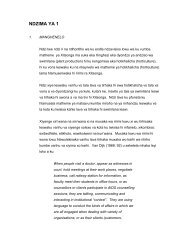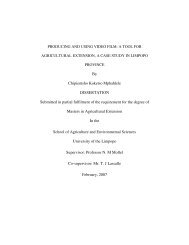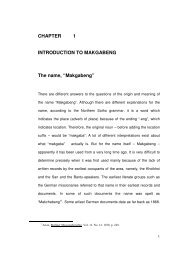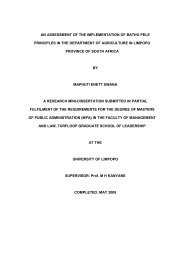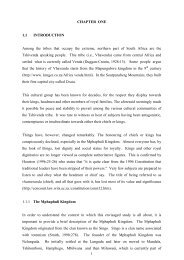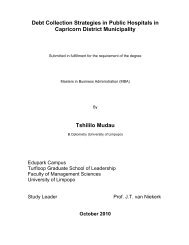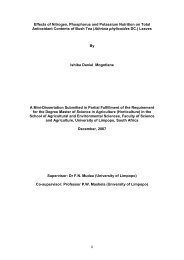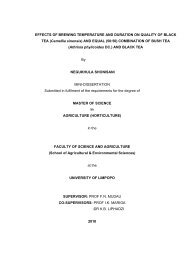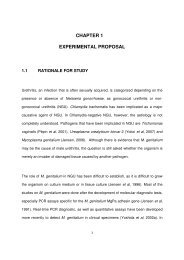Thesis submitted 23-03-2012.pdf - University of Limpopo ...
Thesis submitted 23-03-2012.pdf - University of Limpopo ...
Thesis submitted 23-03-2012.pdf - University of Limpopo ...
You also want an ePaper? Increase the reach of your titles
YUMPU automatically turns print PDFs into web optimized ePapers that Google loves.
The overall reaction may be written as follows:<br />
Fe 2+ + 2Fe 3+ + 8OH -<br />
Fe3O4 + 4H2O<br />
(black colloidal particles)<br />
According to the thermodynamics <strong>of</strong> this reaction, a complete precipitation<br />
<strong>of</strong> Fe3O4 should be expected between pH 9 and 14, while maintaining a<br />
molar ratio <strong>of</strong> Fe 3+ :Fe 2+ <strong>of</strong> 2:1 under non-oxidizing, oxygen (O2) free<br />
environment, i.e inert environment. Otherwise, Fe3O4 might also be<br />
oxidized as:<br />
4Fe3O4 + O2 + 18H2O 12Fe (OH)3 (8)<br />
This would critically affect the physical and chemical properties <strong>of</strong> the<br />
nanosized magnetic nanoparticles. In order to prevent them from possible<br />
oxidation in air as well as from agglomeration, Fe3O4 nanoparticles<br />
produced by equation (1) are usually coated with organic or inorganic<br />
molecules during the precipitation process. To control the reaction kinetics,<br />
and therefore the oxidation speed <strong>of</strong> iron species, the synthesis <strong>of</strong> particles<br />
must be done in an oxygen free environment by passing nitrogen gas.<br />
Bubbling nitrogen gas through the solution not only removes critical oxygen<br />
from the Fe3O4 but also reduces the particle size when compared with<br />
methods without removing the O2. 171,172<br />
3.3.6 Surface modifications <strong>of</strong> magnetic nanoparticles for biomedical<br />
applications and their effect on stability and magnetization<br />
In the preparation and storage <strong>of</strong> nanoparticles in colloidal form, the<br />
stability <strong>of</strong> the colloid is <strong>of</strong> utmost importance. Ferro fluids are colloidal<br />
suspensions <strong>of</strong> magnetic nanoparticles (Fe3O4 or Fe2O3), forming<br />
magnetisable fluids that remain liquid in the most intense magnetic field<br />
strength. As a result <strong>of</strong> their composition, the magnetic fluids (MFs)<br />
possess a unique combination <strong>of</strong> fluidity and the capability to interact with<br />
the magnetic fields. 158,173,174 In the absence <strong>of</strong> any surface coating, Fe3O4<br />
112<br />
(7)


